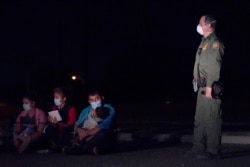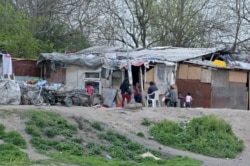Every day, hundreds of Central American immigrants cross the Rio Grande River on rafts from Mexico to Texas. However, on a recent day, many people stood out among migrants wearing T-shirts and jeans.
These people were also generally taller. Some wore skirts and nice shoes. When U.S. border patrol officers arresting them near the river tried to speak to them in Spanish, they did not speak Spanish.
Some of the border crossers explained in broken English that they were Romanians, a Reuters photographer said.
Many Romanians who are part of the Roma ethnic minority have crossed the U.S.-Mexico border in south Texas in recent weeks to seek asylum.
This shows how far away some immigrants are coming. They have added to the high number of recent border arrests, which have reached a 20-year high.
Reuters workers witnessed large amounts of these immigrants crossing the Rio Grande on rafts many times in May. The immigrants explained to Reuters that they were fleeing racism in Romania and wanted to seek asylum in the United States.
The Roma are Europe’s largest ethnic minority and have a long history of social exclusion and discrimination.
Over three weeks, a Reuters photographer saw nearly 200 Romanians crossing at different points along the Texas border. Many groups were extended families of 10 to 15 people.
According to Romanian media reports, many Romanian migrants fly from Paris to Mexico City as tourists. They do not need visas to enter Mexico. Then human traffickers take them by bus to the U.S. border where they cross the Rio Grande by boat or raft.
So far in 2021, border patrol officers have arrested just over 2,200 Romanians. In 2020, 266 Roma were taken into custody. And in 2019 that number was 289. These numbers come from the U.S. Customs and Border Protection agency.
Current arrivals are on pace to be the highest since 2007. That is the earliest year for which citizenship arrival numbers are available.
Margareta Matache is director of the Roma Program at the FXB Center for Health and Human Rights at Harvard University. She said many Roma left Romania to escape oppression and very poor economic situations. Recently, their situation in Europe has worsened from the COVID-19 pandemic.
"Currently, U.S. policies and policy proposals offer hope for more humane and just policies, including for immigrants," Matache said. "They (Roma) are looking for a better life in a place where they are not exposed to violence, discrimination, and disrespect."
Romania's foreign ministry did not respond to a request for comment.
The European Union Agency for Fundamental Rights did a survey in 2016 of nearly 8,000 Roma people in nine European countries. That survey found that about 80 percent of the Roma population was living below the national poverty line.
There is no official population count for Roma people. They live in many countries and have long faced prejudice in Europe and worldwide. Most live in eastern Europe, particularly in Romania, Bulgaria, Slovakia and Hungary.
I’m Anna Matteo.
Adrees Latif in Roma, Texas; Radu-Sorin Marinas in Bucharest, and Ted Hesson in Washington reported this story for Reuters News Agency. Mimi Dwyer wrote the story for Reuters. Anna Matteo adapted it for VOA Learning English. Susan Shand was the editor.
___________________________________________________________
Words in This Story
raft – n. a flat structure (as a group of logs fastened together) for support or transportation on water
pace – n. rate of performance or delivery : on pace to set a record
exclusion – n. the act of shutting or keeping out : the state of being shut or kept out
extended family – n. a family that includes not only parents and children but also other relatives (such as grandparents, aunts, or uncles)
custody – n. immediate charge and control (as over a ward or a suspect) exercised by a person or an authority
survey – n. to ask (many people) a question or a series of questions in order to gather information about what most people do or think about something












